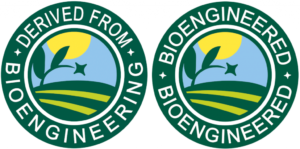"Bioengineered food" — the federal government’s term for food derived from GMOs — is now appearing on product labels across the United States. BE labels emerged after overwhelming public demand for labels on genetically engineered foods led to a patchwork of state-level labeling mandates. In 2016, a federal labeling law known formally as the National Bioengineered Food Disclosure Standard was introduced to replace the state-level actions. Since the law took full effect in 2022, certain foods made with GMOs have carried a bioengineered disclosure.
However, the law’s exemptions and narrow definitions leave many products made with GMO ingredients unlabeled, creating confusion for shoppers. Understanding what the term "bioengineered" means, how it differs from GMOs and what’s missing from the disclosure is essential to protect your right to know how your food was made.
What is bioengineered food (and how is it different from "GMO")?
The USDA defines "bioengineered food" as food for human consumption that contains detectable genetic material (DNA) that has been modified through certain biotechnology techniques. The modifications must be distinct from the changes that are possible through conventional breeding practices or naturally occurring variations.
This definition differs from the internationally accepted definitions of GMOs in meaningful and impactful ways that leave many products outside its scope — even if they contain GMO ingredients.
For example, limiting the definition to products with "detectible modified genetic material" excludes products made from highly refined ingredients — everyday household items such as sugar made from GMO sugar beets or cooking oil made from GMO canola would fall into this category. Even though both are made from GMO ingredients, the processing doesn't leave enough intact DNA for the modification to be detectable — so no BE label.
The law also leaves out products made with newer genomic techniques. Some methods — like CRISPR, TALEN and RNAi — don’t leave detectable genetic material, or there’s no available test. If it can’t be tested, it won’t be labeled.
Which foods require a bioengineered label — and which don't?
The USDA's List of Bioengineered Foods includes the following GMO crops and animals:
- Alfalfa
- Arctic Apple
- Canola
- Corn
- Cotton
- Bt Eggplant
- Ringspot virus-resistant Papaya
- Pink Pineapple
- Potato
- AquAdvantage Salmon
- Soybean
- Summer squash
- Sugarbeet
- Sugarcane
However, many products made from these GMO ingredients won't require a BE label because of exemptions, including these products:
- Animal feed, pet food and personal care products are all exempt from BE labeling, regardless of their ingredients.
- Some foods for direct human consumption are also exempt, such as meat, poultry and eggs.
- Multi-ingredient products in which meat, poultry or eggs are the first ingredient listed are exempt even if other GMO ingredients with detectable modified genetic material are present in the product.
How does this play out in real life? The USDA's example, based on a can of pork stew, shows how exemptions may undermine the label's effectiveness.
Imagine canned pork stew made from several ingredients, including GMO sweet corn. Because of the exemptions listed above, if pork is the first item on the ingredient panel, that product wouldn't require a BE label even if GMO corn appears further down the list. If the first ingredient is water, broth or stock, and pork appears second on the ingredient panel, the product still won't require a BE label because water, stock and broth are overlooked. If the stew contains more GMO corn than pork, the ingredient panel will list corn first and disclosure will be necessary.
In this example, a multi-ingredient product may (or may not) require BE disclosure based on how the ingredients are listed on the label rather than the presence of bioengineered ingredients.
As we can see here, the law's complexity undermines the purpose of GMO labeling: To let US shoppers know whether a product contains GMOs.
What does the bioengineered food label look like? Here's what you'll see on packaging.
Food manufacturers can choose from several options when deciding how to communicate to shoppers that a product contains bioengineered ingredients:

- BE Symbol — The USDA Agricultural Marketing Service developed these new symbols for the BE labeling law.
- Text disclosure — The product package can display a simple text disclosure such as "Bioengineered food" or "Contains a bioengineered food ingredient." This option relies on the unfamiliar term "bioengineered" and doesn't explain what bioengineered means or where the consumer could find more information, which may be confusing.
- Text message or contact phone number — Brands may opt to display the phrase, "Text [number] for bioengineered food information" on the package, or "Call [phone number] for more food information," with a pre-recorded message.
- URL — Very small manufacturers are permitted to direct consumers to a website for information.
While variety gives flexibility to brands, it may confuse shoppers.
A 2023 survey* found that 63% of consumers recognize the term "GMO," while only 36% are familiar with "bioengineering." That gap highlights how many shoppers don’t understand a bioengineered label.
Using the government’s term "bioengineered" without explaining its meaning or providing a link to additional information compromises the label's effectiveness. A label must be consistent, transparent and intuitively understood by the average shopper to be useful.
It’s also important to note that the bioengineered label does not appear on all GMO products, meaning the absence of a BE disclosure doesn't necessarily mean a product is free from GMOs.
How to avoid bioengineered foods
Most shoppers concerned about GMOs want to avoid them, not find products that contain them. The bioengineered food labeling law is insufficient for identifying and avoiding GMOs due to its limited scope, restrictions and exemptions. Too much falls outside of the law's purview for it to be effective.
At the Non-GMO Project, we believe that GMO labeling should be mandatory, meaningful and consistent — and a majority of consumers do, too. After all, everyone has the right to know how their food was made.
Look for the Butterfly if you want to steer clear of GMOs — and bioengineered foods! It's the most trusted label for avoiding genetically engineered food while supporting a transparent and accountable food system.
FAQ
Is "bioengineered" the same as GMO?
No. “Bioengineered food” is the federal government’s term for GMOs, but it has a narrower definition. Some products made with GMOs are not considered bioengineered and do not require a BE label.
Which foods are considered bioengineered by the USDA?
The USDA's list of Bioengineered Foods includes alfalfa, Arctic Apple, canola, corn, Bt eggplant, papaya (ringspot virus-resistant), Pinkglow Pineapple, potato, AquAdvantage Salmon, soybean, sugarbeet, sugar cane and summer squash.
Does a product without a BE label mean it’s GMO-free?
No. Many GMO-derived foods are exempt from the bioengineered labeling law, so the absence of a BE label does not guarantee a product is free from GMOs.
How can I avoid GMOs and bioengineered foods?
Look for the Non-GMO Project Butterfly. It's the most rigorous, trustworthy and transparent certification for avoiding GMOs — including all bioengineered foods.
*Source: Linkage Research & Consulting, "Research Report: Non-GMO Project 2023 Market Tracking," 2023.
